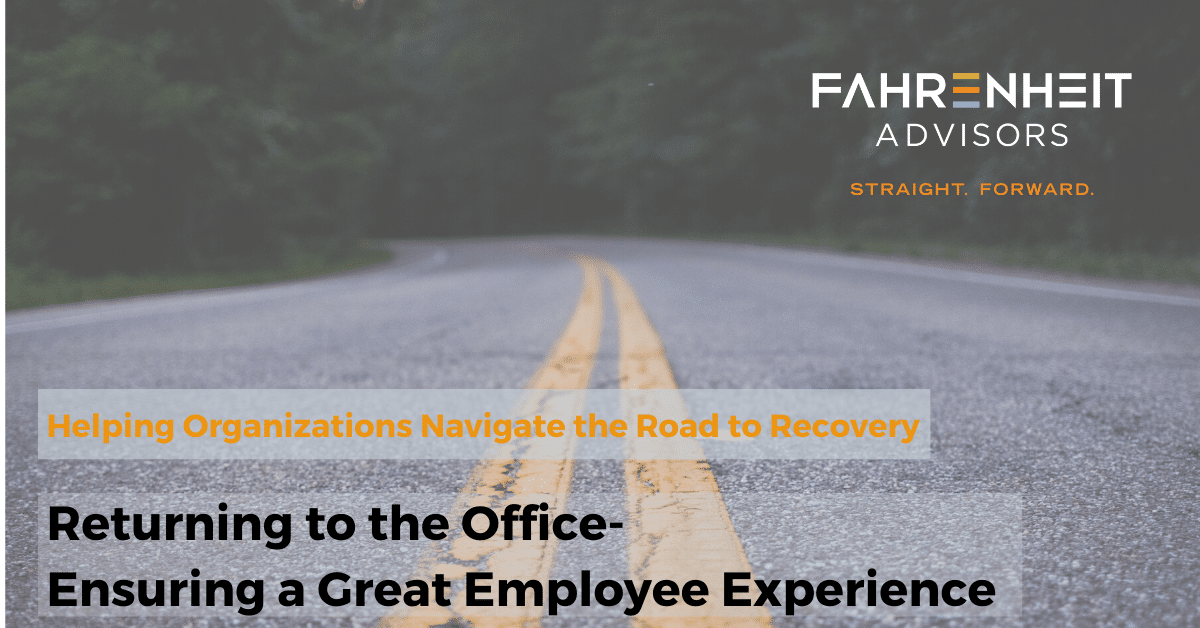Returning to the Office-Ensuring a Great Employee Experience
 While many of us continue to work from our home office or dining room tables your leaders and HR are starting to think about what will need to happen to return to the office. Among my HR friends (and colleagues) we’ve talked about the difference between the phrases “Return to Work” and “Return to the Office”. If you stop and think about it…there is a difference. We’ve all been working during this time, with some days longer than the usual time we would have spent in the office. The work hasn’t stopped, but the place we do it has changed.
While many of us continue to work from our home office or dining room tables your leaders and HR are starting to think about what will need to happen to return to the office. Among my HR friends (and colleagues) we’ve talked about the difference between the phrases “Return to Work” and “Return to the Office”. If you stop and think about it…there is a difference. We’ve all been working during this time, with some days longer than the usual time we would have spent in the office. The work hasn’t stopped, but the place we do it has changed.
Returning to the office will take planning. Not just a quick checklist but planning on a scale that has lots of parts. We need to put the health and safety of our employees, customers, clients, vendors, and anyone else we may come in contact with front and center. Of course, we will conduct business but it won’t be business as usual. Leaders will need to think about everything from logistics (who can enter the office, whether to take temperatures or not, seating distances for meetings, common area usage, requiring a mask or not) to how employees are feeling on a daily or even hourly basis. While this won’t be business as usual we create, communicate and put into place processes to ensure that people feel safe and are happy to come to work (even if we still aren’t greeting each other with a handshake!).
- Consider having cleaning supplies readily available in conference rooms, open areas, and desks. Inform people ahead of time what items will be supplied.
- Establish maximum occupancy in office and conference rooms- make sure that everyone is aware of the safe number by placing signs at door of conference rooms and communicate ahead of time. Remove excess chairs so maximum occupancy harder to breach.
- Consider high touch areas (printers, refrigerators, doors) and ways to minimize germs such as buying extra printers or supplying gloves or wipes.
- Establish a traffic flow and make sure to clearly mark. Communicate ahead of time to ensure people are aware before entering.
- Consider have extra cleaning cycles from a professional crew and communicate to employees.
- Communicate expectations from continued work from home to staggered shifts in the office.
- Establish protocols if someone tests positive or is directly exposed.
- But most of all communicate, communicate, communicate.
- It’s important that Senior leadership follows the new protocols, so the example of proper behavior is apparent.
It is key for leaders to be visible and available to employees. Communicate information to keep the guesswork out of it. Make sure employees understand the priorities and that changes have been made. Remember, employees have not been in all your leadership discussions won’t know what you are thinking and understand decisions you have made to ensure their safety. Make sure you are authentic and transparent. Find out how people are doing by asking about the transition back into the office. Sharing your own feelings about your experience helps employees feel connected.
Throughout this experience it’s important to be flexible and remember that everyone will have a different comfort level. Be respectful of differences of opinion, but follow the protocols to keep everyone safe. Let’s start getting excited for our Return to Office adventure.
 About the Author
About the Author
Jennifer Stern serves as HR Director for Fahrenheit Advisors. She has over 20 years of HR experience and is a proven leader, skilled at developing collaborative working relationships, including cross-functional teams within an organization. She is a results-oriented, highly motivated HR professional with associate relations, generalist, recruiting and management experience, which is reflected in the work she does here at Fahrenheit. Contact Jennifer at jstern@fahrenheitadvisors.com
